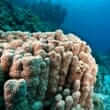Background
- Corals are sea animals that grow in colonies. Corals are most often found in tropical oceans and are known as reef builders because they secrete calcium carbonate to form a hard skeleton.
- Natural and man-made coral are currently being studied for use in bone grafts. Coral has been shown to increase bone strength when incorporated into surrounding bone.
- Although coral may be useful as a bone graft substitute, researchers state that more long-term information on safety and effectiveness is needed. Coral has been associated with an increased rate of infection and may cause problems in those who have or are prone to kidney stones.
References
- Bizette C, Raul JS, Orhan B, et al. [Results of cervical interbody fusion with coral grafts]. Neurochirurgie 1999;45(1):4-14.
View Abstract - Boutault F, Cantaloube D, Testelin S, et al. [Role of coral blocks in cheek augmentation surgery. Prospective study of 23 patients]. Ann Chir Plast Esthet. 1997;42(3):216-222.
View Abstract - Jordan DR, Gilberg S, Mawn L, et al. The synthetic hydroxyapatite implant: a report on 65 patients. Ophthal Plast Reconstr Surg. 1998;14(4):250-255.
View Abstract - Marchac D, Sandor G. Use of coral granules in the craniofacial skeleton. J Craniofac Surg. 1994;5(4):213-217.
View Abstract - Martov AG. [The place of supravesical endourology in the modern combined treatment of urolithiasis]. Urol Nefrol (Mosk) 1994;(6):5-9.
View Abstract - Mercier J, Piot B, Gueguen P, et al. [The coral orbital floor. Its value in traumatology. The results of a multicenter study of 83 cases]. Rev Stomatol Chir Maxillofac. 1996;97(6):324-331.
View Abstract - Schulz A, Hilgers RD, Niedermeier W. The effect of splinting of teeth in combination with reconstructive periodontal surgery in humans. Clin Oral Investig. 2000;4(2):98-105.
View Abstract - Vuola J, Bohling T, Kinnunen J, et al. Natural coral as bone-defect-filling material. J Biomed Mater Res. 2000;51(1):117-122.
View Abstract







